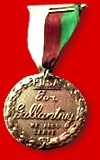  | |
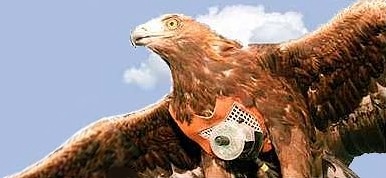
The truth is that peregrine falcons were used during the war perhaps not to the extent that pigeons were but non the less also did play a part in the defense of Britain, A trained force of falconers was set up to counter the menace of Nazi spy birds that were carrying info out of England. The accounts can be found in the public records office in Kew. This information was only released in Jan. 27 1999 by the Secretary of Military News. |
White bird down leads to delicate rescue operation By Arieh O'Sullivan / Thw Media Line and Jerusalem Post Online Tuesday, August 30, 2011
Since Israel and Sudan have no formal diplomatic relations, third parties were called in and American and German figures were able get hold of the transmitter before it fell into the wrong hands. “We trapped and marked six great white pelicans with satellite GSM and GPS transmitters and wing tags,” Ohad Hatzofe, an avian ecologist for Israel’s Nature and Parks Authority (NPA), told The Media Line. “It was used to monitor and better understand pelican movements …. None of it is for espionage, as sometimes we are accused of by our neighbors in the Middle East, unfortunately.” But one of the birds was trapped and died in a fisherman’s net in southern Sudan. The father of the fisherman retrieved the transmitter from its back. Instead of turning it over to authorities; he noticed a German e-mail address imprinted on the device and sent a message that they had found it. Normally, tracking animals and birds for scientific purposes would not have required such sleuthing. But an increasing paranoia of Israeli zoological militancy conspiracy theories has made such incidents fodder for claims Israel was using wild animals to spy or attack people. Last January, Saudi Arabia claimed to have detained an eagle for being a Mossad spy. Earlier, the south Sinai governor suggested that a shark that killed a tourist in Sharm el-Sheikh had been intentionally released by the Mossad to sabotage tourism in the area.
Two of the GPS-carrying pelicans died, one was badly wounded and a third was lost, but others two had been sending back data until recently. According to Hatzofe, one transmitted that it spent a few months in Lake Nasser near the Aswan Dam in Egypt and then made its way to central Turkey, revealing a previously unknown breeding ground. He was busy tracking the final bird, which spent the winter in southeast Sudan and occasionally crossed into Ethiopia. “It started to move across the Blue Nile slowly in the summer. For some reason, this bird, a male, gave up the spring migration. We don’t know why,” he said. Hatzofe said he knew something was wrong when it started to transmit it was going upstream and then it started to signal mortality. The bird had an Israeli band on its leg, but the transmitter was marked with a German address. “Our colleague in Germany got an e-mail from a Sudanese guy who informed him he got a bird with an Israeli ring, or band, and that’s how the contact was made,” Hatzofe said. According to him, an American wildlife conservationist in Khartoum, who would not be named for fear of repercussions for having contact with Israelis, agreed to track down the fisherman and retrieve the entire transmitter kit and send it back to Israel via Germany. The teams in Israel are anxiously awaiting its arrival because it holds an enormous amount of data that were not transmitted while the pelican was alive, including minute-by-minute details of its altitude, speed of flight, length of stay and precise positions. “Birds know no political boundaries,” Hatzofe said. But precise reports such as this lend credence to Arab propaganda that the Jewish state has no boundaries when it comes to collecting intelligence. Stories of sharks, raptors and rodents used by a “Zionist plot” continue to appear. In 2007, Iran’s state-sponsored IRNA news agency reported that 14 squirrels working for the West had been arrested with spy gear. A year later, Iran announced it nabbed two pigeons with “invisible strings” staking out a nuclear site in Natanz. “We can be enemies or have disputes on water or borders or other issues, but birds and other wildlife belongs to all of us and we have to cooperate,” Hatzofe said. “We actually do have cooperation across the borders with some colleagues in countries that we are technically enemies. Ignorance causes these stupid beliefs that they are used for spying.” |
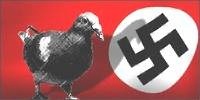 Airborne threat of Nazi pigeons Airborne threat of Nazi pigeons Source: BBC News, 2001-10-08 Originally published January 27, 1999 Nazi-trained homing pigeons were the target of British covert operations during WWII, it has emerged. Scores of lofts of the message-carrying birds were pinpointed by MI5 agents in 1940 across Belgium, West Holland and the Balkans. The airborne threat was believed to be the pet project of SS chief Heinrich Himmler - who was known by British intelligence as an avowed pigeon fancier. Under interrogation, captured "German pigeon personel" told how the birds were a vital component of Hitler's plans to invade Britain. The MI5 report on the phenomenon, released with a batch of wartime secret service documents this week, said: "From these prisoners of war it was learnt that it was anticipated that the birds would be used to convey information obtained by short-term pre-invasion agents." To counter the menace, MI5 tamed and trained its own crack force of peregrine falcons, with the aim of felling incoming pigeons. 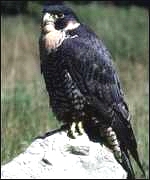 According to documents now held at the Public Record Office in Kew, London, at least two of the captured pigeons became "prisoners of war". Displaying humour in the midst of adversity, an intelligence officer marked in his report: "Both birds are now prisoners of war working hard at breeding English pigeons." The new Army Pigeon Service Special Section birds of prey were used to set up an airborne net over the Scilly Isles early in 1942 following sightings of pigeons disappearing towards France. The MI5 report notes Britain's new anti-pigeon force would patrol for two hours at a time over the islands off the Cornish coast. It says: "This was a great success. The falcon flying high above the Scillies could watch not only a part of one island, but the whole group, and any pigeon flying over them would be attacked." Agents had found that the Nazi party had taken control of all pigeon lofts in Germany after it assumed power, while Himmler had ordered the use of pigeons by his own Gestapo security police. The British document notes: "It is said that Himmler, who has been a pigeon fancier and enthusiast all his life, is the head or president of the German National Pigeon Society. "And he has brought his enthusiasm for pigeons into the Gestapo, who are said to use this form of communication both in Germany and in the occupied countries." Intelligence officers also investigated ways in which pigeons were deposited in the UK. They believed some were carried in by individuals, and that some were dropped off in baskets by high-speed E-Boats and submarines. Dropping pigeons by parachute was also identified as a possible method of their entering the country. |
file ref KV 4/229-231 These files relate to the Security Service's interest in Britain's post-war pigeon policy, which was led by the Joint Intelligence Committee. Covering 1945-1947, file KV 4/229 deals with the establishment of a post-war sub-committee of the Joint Intelligence Committee to examine pigeon policy. The Security Service was initially not included in this committee, and when it was, there was a conflict with the Secret Intelligence Service about whether a military or civilian pigeon loft should be maintained (eventually the Security Service view won out, and a civilian loft run by Captain Caiser from his home in Worcester Park was established).
The story continues in file KV 2/230 (1947-1949). The armed services dropped out from the sub-committee in November 1948, having no further interest in the subject, leaving just the two intelligence agencies and Captain Caiser. There was some correspondence about the control of pigeons in a future war with the Home Office as it updated defence regulations. JIC asked the sub-committee to examine the impact of radiation on homing pigeons, and as a result a number of pigeons (and their handlers) were exposed to small doses of gamma radiation in the Arethusa experiment at Portland dockyard, to no recordable effect. Finally in 1950, as recorded in file KV 4/231, Caiser asked the Security Service for some funding for his expenses in maintaining the government loft, which triggered an examination of the costs and benefits of the loft. As the loft had barely been used in five years, the Service recommended that the loft be disbanded and the Pigeon Committee wound up. This was agreed in May of that year. | ||||
|
British intelligence and covert action Absurdity crept in when MI5 installed Lord Tredegar, a well-known falconer, on the south coast of England with his birds as part of the Falcon (Interceptor) Unit with instructions to hunt down any suspicious-looking carrier pigeons that might pass by. MI5 later had Lord Tredegar imprisoned in the Tower of London for revealing his work to a fellow peer. The confession St. John Newland The Ministry of Defence made public some secret files which contained details of an amazing secret weapon which MI5 seriously considered using during the Cold War. This secret weapon was so deadly it could wipe out whole cities in enemy territory, and would be so fearsome that it would reduce enemy countries to their knees. It could slip in and out of enemy lands without being seen and was undetectable to radar. What was this terrifying and awesome secret which would wreak havoc on any potential enemy? What was this fearsome and devastating weapon? It was the common pigeon. Yes, believe it or not, during the 1940's the government's Air Ministry had a special pigeon section, run by Wing Commander William Rayner. Rayner devised a plan whereby pigeons could be trained to fly into enemy territory, with a small explosive device carrying deadly poison strapped to their backs. The pigeons would be flown in a plane over enemy lines and then dropped so they would fly to their destinations and release their deadly cargo. Sadly, it was discovered that the pigeons would not survive the attacks, but it was said that the pigeons were willing to make the ultimate sacrifice for King and country. What was perhaps more disturbing though was that the Germans had commandeered thousands of pigeons for similar purposes. But the MI5 file ends by saying that the Air Ministry also had what was known as the Anti Pigeon Falconry Unit. And this Unit had trained British falcons to intercept and kill any enemy pigeon that flew into British airspace. Isn't it reassuring to know that the government thinks of everything! | Historic messengers that flew home The Times (London), Saturday, April 20, 2000 Just prior to founding Reuters in 1851, Paul Julius Reuter found a niche delivering the latest news and information using the fastest technology available. In 1850 the technology was a fleet of 45 pigeons that would deliver news and stock prices between Brussels and Aachen, Germany within two hours, beating the railroad by six hours. Reuters History > History of Information and Innovation |
Brits' pigeons of mass destruction revealed ABC News, Saturday, May 22, 2004
British intelligence agents secretly discussed plans to attack the Soviet Union with pigeons armed with biological weapons, documents made public by the National Archives reveal. The bizarre Cold War scheme was hatched by Wing Commander WDL Rayner, a Royal Air Force officer who, in the aftermath of World War II, saw suicide pigeons as the future of warfare. He was part of a top-secret "pigeon committee" set up after the war amid concerns that lessons learned from using pigeons to carry messages through Nazi German lines would be lost as the British military disbanded its flocks. Rayner's idea called for pigeon lofts to be situated around Britain at locations with the same electro-magnetic and coriolis values as potential Soviet targets. 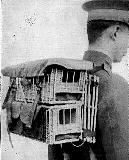
If war broke out, the birds - whose homing instincts depend on such values - would be released, each carrying a 55-gram capsule loaded with a "bacteriological warfare agent" such as anthrax. "A thousand pigeons each with a two-ounce explosive capsule landed at intervals on a specific target might be a seriously inconvenient surprise," Rayner wrote in a paper to the committee. But the idea ran into turbulence from Britain's domestic intelligence agency MI5, which branded Rayner "a menace in pigeon affairs" and disputed his participation on the committee. In the end, Rayner's plans for a full-scale experimental pigeon loft, with about 400 birds, never got off the ground, due to wrangling between the intelligence services and armed forces over who should pay for it. The National Archives in London regularly releases intelligence documents no longer deemed to be top secret. Most are from World War II but some cover the pre- and post-war period. -- AFP |
Cold war bomb warmed by chickens BBC News, Thursday, 1 April, 2004
Civil servants at the National Archives say it is a coincidence the secret plan is being revealed on 1 April. The Army planned to detonate the seven-tonne device on the German plains in the event of having to retreat. Operation Blue Peacock forms part of an exhibition for the National Archives, in Kew, London, on Friday. Professor Peter Hennessy, curator of the Secret State exhibition, told the Times: "It is not an April Fool. These documents come straight from the archives at Aldermaston. Why and how would we forge them?" The bomb was designed to stop the Red Army advancing across West Germany during the height of the Cold War. But nuclear physicists at the Aldermaston nuclear research station in Berkshire were worried about how to keep the landmine at the correct temperature when buried underground. In a 1957 document they proposed live chickens would generate enough heat to ensure the bomb worked when buried for a week. The birds would be put inside the casing of the bomb, given seed to keep them alive and stopped from pecking at the wiring. The landmine would be remotely detonated. Tom O'Leary, head of education and interpretation at the National Archives, told the paper: "It does seem like an April Fool but it most certainly is not. The Civil Service does not do jokes." |
during wartime A short article by the master of controversy - "Spinksy" It is a little known fact to the public at large that racing pigeons and their owners played a major role during wartime towards the eventual peace. Pigeons were deemed to be of such importance that special services were set up by military commanders for the purpose of news relay and espionage. Whilst radio transmissions could be intercepted - the pigeon went silently with speedy efficiency. Barely a single aircraft left base without their trusty pigeons in case of mishap, and ground troops used them to fullest potential from points behind enemy lines. One wonderful account is given on Boglin Marsh Portal via the pen of the late Captain W. Mather who served with the Indian Pigeon Service which was just one of many that were active in various theatres of war. Pigeons braved all seasons and conditions to bring the vital messages through - they were flown over oceans, deserts and even through the densest of jungle. They carried photographic equipment for survey purposes of enemy troop movement or armament cache - they were even used to disable enemy searchlights when missions were in progress. The Middle East Pigeon Service started with 6 birds, during January 1942; developed large breeding lofts on the edge of the desert at Digla, Cairo, under Lt.-Col. Hollingworth as C.S.O. Pigeons and served the 8th Army in North Africa and Italy. They also served the 9th Army and the R.A.F. to develop the Nomad System (this was a two way system similar to the Boomerang method and using mobile lofts) - on this system a 6 months old hen pigeon carried a message back to base from a distance of 500 miles, 260 miles of which was over water. The Nomad System was developed as an alternative to parachuting pigeons into isolated areas. The pigeon was trained to leave an aircraft at 1,000 feet and recognise a marked basket in a field or open area, then pitch into it, returning to its home loft later with a message attached. It was used in the Middle East and also the Ruhr area (see 'Ruhr Express' - trained on this method) The Indian Pigeon Service used the Boomerang System, where pigeons were trained to fly both ways between two lofts - one to feed, the other to nest and were able to do this and navigate through dense jungle over 25-30 miles and behind enemy lines in Burma and Malaya. Some of these lofts recorded over 1,000 successful flights with message carrying pigeons and the true value was in the number of lives that were not placed into positions of further risk, due to the valuable information obtained. There were secret Pigeon Services in France (Maquis), Holland, Belgium and Denmark, where those involved risked death for keeping pigeons. These also supplied vital information of enemy troop movements etc. Other valuable service was rendered by American, Canadian, New Zealand and Australian Pigeon Services. Many of these birds were trained in the dark by the NPS, dopped by parachute and then flown in the dark with news supplied by the Maquis, to cross the English Channel before daybreak. There is no end to the wonder of a noble racing pigeon! |
Boglin Marsh: The Boomerang System of Pigeon Racing As related to me by Capt. W. (Bill) Mather. CHAPTER ONE INTRODUCTION It is a well known fact that pigeons were used on the Boomerang Two Way System to carry messages during the last war. So while I obviously did not invent the system, I do claim that I helped to perfect it, while serving as a Signal man and later as an officer in the Indian Pigeon Service, from 1942 until 1945. The Indian Pigeon Service was formed in 1941, when a small draft of Signals personnel, under the very capable leadership of Major Swarbrick, was allotted the immense task of organising a pigeon service in a gigantic country like India. The hazards of climate, distances, disease, hawks, killer ants, white ants and scores of other obstacles were tremendous. To a large extent all were overcome and at any rate they were exciting, interesting and eventful years that we spent together. I had been in India some time when the Indian Pigeon Service was formed and any fancier will realise how pleased I was when I heard that I was to receive my transfer to the new pigeon section. Right at the start I was very keen to listen tom the stories of other fellows who had been on experimental Boomerang work back home. At first we did no Boomerang training at all, it was considered to be a long drawn out affair and difficult to lay on quite a two way short service. I had other ideas and asked to be allowed to try my hand at putting on a four mile service; to the great amusement of all concerned, my request was granted. I was given a few very doubtful looking specimens of pigeons and three weeks in which to complete the task!
This to my mind was completely unnecessary and the wrong approach; I was of the firm opinion that the crate could be moved or jumped any required distance up to twenty five miles. To cut a long story short, I did not require the three weeks, nor anything like it, that had been allowed to me for my very first Boomerang effort. The service was working perfectly in exactly five days! Later on, with experienced Boomerang pigeons and a further improvement by very good friend Sergeant S. A .Hardy (of Hardy Bros. Forrest Hill F.C.) we were able to lay on a sixteen mile service within three days through thick jungle country, where one spot was indistinguishable from any other. The speed with which the birds completed their two-way trips always fascinated me; even poor specimens of birds were able to put up good times under very trying conditions and we had a few really good birds relaying messages through tropical monsoon storms! |
|
CIA gadget museum showcases spy secrets Robot fish, tiger dropping microphone among gadgets on display MSNBC, The Associated Press, Dec. 26, 2003 Exhibits include the jungle transmitter, a robotic catfish, a remote-controlled dragonfly and a small camera strapped to the chests of pigeons and released over enemy targets as recently as the 1970s. The secret gadgets currently used by CIA are left to the imagination of visitors. The pigeon missions remain classified, made possible only after the CIA secretly developed a camera weighing only as much as a few coins. An earlier test with a heavier camera in the skies over Washington failed after two days when the overburdened pigeon was forced to walk home. “People don’t think of a pigeon as being anything more than a rodent on top of a building,” said Pat Avery of Newalla, Okla., who runs the National Pigeon Association and recounts exploits decades ago by famous military pigeons such as “Spike” and “Big Tom.” But as surveillance technology improved, the need for CIA pigeons diminished. “They’re pretty passe now,” she said. |
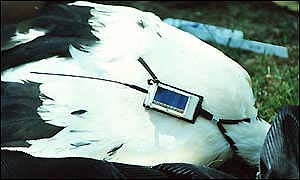 Tuesday, 9 October, 2001
Tuesday, 9 October, 2001feathered 'spy' Police in Burundi have arrested a bird suspected of spying By Mohammed Allie in Cape Town, BBC News, The South African stork, which had a satellite tracking device attached to its body, was found by villagers after injuring a wing. The alleged spy is a white stork named Saturn which was a member of a flock of five that formed part of a University of Cape Town research programme to monitor the migration patterns of the birds. The other four birds, which were also fitted with the same devices, died in February after heavy rains in Mozambique. 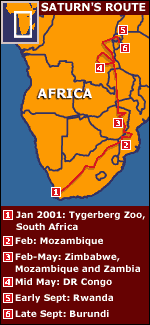 Crash landing
Crash landingSaturn apparently crash landed in a village in Muyinga Province in north-eastern Burundi after injuring a wing. Upon closer inspection local villagers were intrigued by the suspicious looking electronic device strapped to the bird's body. Understandably, there was great consternation and the bird was immediately handed over to the local police for investigation. The Burundian police then enlisted the assistance of English-speaking Mary Murphy who lives in the area. Concern Fortunately, the satellite device had the email address of Professor Les Underhill of the University of Cape Town written on it. Ms Murphy then emailed Professor Underhill saying the sick bird, together with its suspicious device, had been taken into custody. She added that Saturn's right wing was healing and that he was being cared for by the police. There was no mention whether the bird was being held under 24-hour armed guard in the police cells. Professor Underhill said he understood the police's concerns, especially in today's environment of terror attacks. "The device looks pretty space age with an aerial and a little solar cell to charge the battery," he said. But he remains hopeful that both the bird and the satellite device will eventually be returned unharmed. |
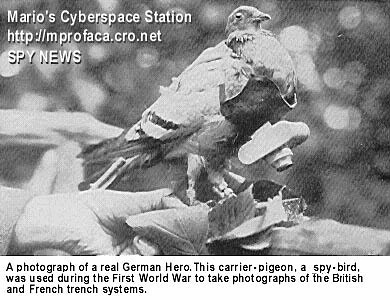
From: Nigel Wylde mailto:Nigel.Wylde@btinternet.com Sent: Sat. March 11, 2000 1:22 PM To: Mario Profaca Subject: Spy Birds  The recent reports of supposed High Tech Birds spying for Pakistan, which have subsequently been claimed to be sporting birds, has prompted me to send you a photograph of a real German Hero. The bird was used during the First World War to take photographs of the British and French trench systems. How the bird was tasked, tracked and recovered is not mentioned in the documents I have. Nor is there any mention of how the photographs were related to ground and evaluated. Still it shows the inventiveness of the mind that such an idea was deemed worthwhile.
The recent reports of supposed High Tech Birds spying for Pakistan, which have subsequently been claimed to be sporting birds, has prompted me to send you a photograph of a real German Hero. The bird was used during the First World War to take photographs of the British and French trench systems. How the bird was tasked, tracked and recovered is not mentioned in the documents I have. Nor is there any mention of how the photographs were related to ground and evaluated. Still it shows the inventiveness of the mind that such an idea was deemed worthwhile. |
|
From: Nigel Wylde
mailto:Nigel.Wylde@btinternet.com Sent: Sun. March 12, 2000 2:37 PM To: Mario Profaca Subject: Re: Spy Birds Mario I have no objections to you putting the original on Spynews complete with my address. The photograph is First World War. It came from a book called Die Weltkriges-Spionage published in 1931 by Verlag Justin Moser in Munich. The book has 71 chapters, each written by a former German Intelligence Officer, and was compiled by the publisher in their words as 'An authentic account of the methods, work, technology, handling, results and secreacy of Spying'. Sadly it is in German and printed in Old German Gothic Script. The book is the best I have found on the subject of spying. I doubt many were published and very few will have survived. It is 700 pages long and just a bit larger than A4 in size. It contains over 600 photographs, drawings and tables taken from official German records some of which I can send you from time to time if you are interested. Many of the photographs are of executions of what are claimed to be spys. Some of the subjects covered are: ' Pigeon with Photgraphic Apparatus'. I woul describe that as a very germanic description. The book has been owned by my family since 1931.
|
http://mprofaca.cro.net/spynews.html SPY NEWS Tuesday, March 07, 2000 http://news.bbc.co.uk/hi/english/world/south_asia/newsid_668000/668974.stm Hawks suspected of spying for Pakistan are in fact being used for sport, according to a senior police officer in the Indian desert state of Rajasthan. Shantanu Kumar, who is also a keen falconer, was responding to claims which arose after India's Border Security Force came across a number of hawks carrying what seemed to be high-tech surveillance equipment. 
The Indian press said the 'spyhawks' had been working for Pakistan after they all seemed to settle on the towers of Indian military installations. But Mr Kumar said the creatures belonged to Arabs who took them to Pakistan to hunt their favourite prey - bustards. He said the transmitters attached to the bird's tail-feathers were there to help their handlers find them when they get lost. Tuesday, March 07, 2000 http://news.bbc.co.uk/hi/english/world/south_asia/newsid_668000/668974.stm
NEW DELHI (March 6) : India's Border Security Force (BSF) has caught a hawk allegedly used by Pakistan for spying purposes, the Press Trust of India
reported on Sunday. Tuesday, March 07, 2000 http://www.foxnews.com/etcetera/030700/hawk.sml Indian authorities capture hawk used for Pakistani spying
NEW DELHI - India's Border Security Force (BSF) has caught a hawk allegedly used by Pakistan for spying purposes, the Press Trust of India reported Sunday. In a report from Jaipur, capital of the western state of Rajasthan, the agency said: "The BSF caught one more spy hawk fitted with antenna and a live transmitter flying across the international border. Monday, March 06, 2000 Radio Australia World News http://www.abc.net.au/ra/newsdaily/rael-6mar2000-42.htm India's Border Security Force has caught a bird allegedly used by neighbouring Pakistan for spying. The Press Trust of India says the bird - a hawk - was fitted with antenna and a live transmitter. It was caught in the Jaisalmer border region of the western state of Rajasthan and is believed to have been used to monitor Indian army movements. It's the second hawk to be captured by the Border Security Force in the past three weeks. |
|
Parrot Puts Foul-Mouthed Cops to Shame Mohammed Ashraf • Arab News TRIVANDRUM, 17 August 2004 — Cops at the Malayinkizhu police station on the outskirts of the city are in a dilemma. A parrot they "arrested" a year ago is welcoming everyone who comes to the station in true Kerala police style...using every available four letter word and police bosses are no bar. One cannot blame Mittu, the parrot. He is a quick learner who has seen the best of both worlds. He was the conscience-keeper of master thief Poocha Saju, Saju the "Cat", before he came into police custody. Saju had trained him well to keep a watchful eye on "suspected elements," especially the cops. Trailing the notorious criminal, the police had to confront his close confidante on several occasions. "We were duped several times by this bird," said Jnana Das, the sub-inspector of the police station explaining that it took several days for the policemen to understand that the parrot was really helping the criminal to give a slip from the police dragnet. "Run run, police police... The bird had been trained well to spot us from a long distance and chirp," he said. Taken into "custody" for his dubious roles, (his former employer was netted only recently), "Mittu" was quick enough to learn the police "language". "When he gets angry he keeps chirping four letter words with ease," lamented a constable who feeds him. Worried, the cops have almost stopped using expletives, at least before the little winged guest. "No doubt, it has helped us a lot to reform," a policeman admitted grudgingly. But there is another side to it. Despite the nuisance created by "Mittu," the policemen are now in no mood to part with their friend. "We don't know what to do? We cannot free him because untrained in natural surroundings he will become a prey to bigger birds," another policeman said. But of course, there is a sliver lining: Senior police officials are aware of "Mittu" and its new abode. |
|
Back to Nature for Micro Spy Plane Builders By Sarah Cade, PA News Tue 17 Feb 2004 Bird and insect flight could help scientists hoping to build a spy plane the size of a bee, it emerged today. The micro aircraft, which would be up to 6ins (15cms) long and weigh about 1.75oz (50 grams), will be equipped with sensors and cameras to carry out military missions. Researchers from the University of Bath believe the way bees, flies and birds flap their wings could hold the key to powering miniature unmanned aircraft. Dr Ismet Gursul, who is leading the research, said: “We are looking for the most efficient way of flying, and the rapid flapping of a flexible wing is one of these, and in this respect we are imitating nature and the flight of insects and birds.” If the research is successful, miniature cameras will be attached to the plane to send back clear detailed video footage of battlegrounds. Tony Trueman, a spokesman for the University of Bath, said the technology would have a “significant” effect upon civilian life and modern warfare. “Such a device would allow commanders to use their troops most effectively and would avoid the need for human scouts to risk their lives,” Mr Trueman said. “They can also land on the roof of enemy vehicles and mark them for future attack or as carriers of chemical or biological weapons. They are unlikely to be used directly as weapons.” He added that the aircraft could make non-military tasks easier, such as traffic monitoring, border surveillance, fire and rescue operations, wildlife surveys, aerial photography, monitoring of seismic activity and hazardous substance detection. But scientists realise the project will be tough as small aircraft are vulnerable to high winds. Dr Ismet Gursel, head of the Aerospace Subgroup at the university’s Department of Mechanical Engineering, said: “The smaller an aircraft is made, the slower is its speed and the more it is vulnerable to high winds. “This means that existing micro air vehicles can only fly for short periods at low speed and are too large to carry out fine manoeuvres.” Dr Gursel said he hoped the team could imitate the efficiency of nature to keep smaller aeroplanes in the sky for long enough to carry out their tasks. The team of scientists said the current pool of knowledge about bird and insect flight was “limited” and they hope the research will break new ground in understanding the stamina of a bee and the agility of a dragonfly. Dr Gursel added that the team would also research the possibility of using micro jet engines which send out small puffs of air to push the aeroplane forward. The Department of Mechanical Engineering at the University of Bath plans five research projects over the next two years funded by the Ministry of Defence, BAE Systems, the Engineering and Physical Sciences Research Council and the US Air Force Office of Scientific Research. The main problems with the micro air vehicles that the research will look into are poor lift, inefficient propulsion and unsteady aerodynamics. Mr Trueman said researchers at other universities were developing the computer software and hardware needed for the micro air vehicles to be able to travel to preset destinations and avoid obstacles, without having to be guided remotely. |
|
Who's looking at you? The Birdhouse Spy Cam by Grant McOmie, August 16, 2004 PORTLAND, Ore. - West Linn resident, Richard Yost is the first to admit that his idea was fairly amibitous: to see what goes on under the roof of a backyard birdhouse! Now, it's become a place that Yost can't get enough of: "You really do! You almost get addicted to it." Yost is a zoologist by education and training, and he has placed more than a dozen birdhouses acorss his wooded suburban homesite. But if you look closely at each birdhouse, you'll see that Yost has wired each with a TV camera and a cable. "I'd see the bird's go in and I didn't really know what they were doing inside. That got me wondering: what is going on in there?" He got the idea a couple of years ago while watching the birds and squirrels in his yard. After a few experiments, he eventually linked the cameras to his own TV and discovered a new world of behavior that you might expect --- but never get to see. Parents feeding chicks, youngsters practicing to fly, sibling squirrels playing with each other, and also some amazing surprises.For example, a parent bird ate the leftover egg shells from her newly hatched young. Yost had never seen that before. Yost took his curiosity and packaged it: 100 feet of cable, a power supply and an infra-red camera that works day or night. He recently teamed up with a birdhouse builder to offer a complete package for sale. He supplies these to researchers and homeowners alike.In fact, Yost's bird cameras have been used across the country by more than twenty schools and wildlife researchers who are studying animal behavior. Called the "Birdhouse Spy Cam," the idea is based upon Yost's youthful fascination for birds. "It's like with all science --- you don't know until you find one little thing which may lead to another and another - you never know." If there's one thing that Yost does know, it's that science and technology can provide incredible opportunities to learn. |
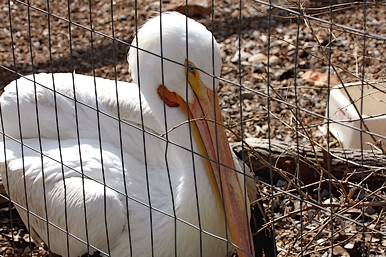

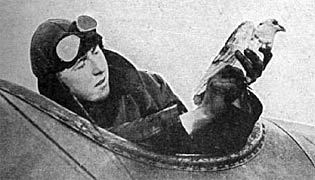
 The mine would be kept warm
The mine would be kept warm